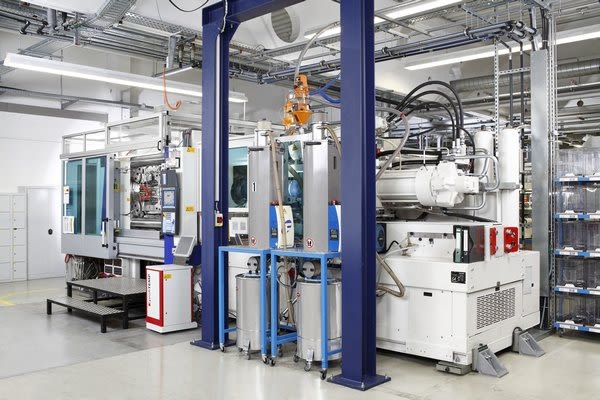 Process stability is a concept that embodies the idea of uniform quality with minimal scrap. The new adaptive process control (APC) machine function from KraussMaffei provides this stability even though with continuous changes. The customer KH Foliotec utilizes APC in the production of premium quality interior components with in-mold labeling (IML).
Process stability is a concept that embodies the idea of uniform quality with minimal scrap. The new adaptive process control (APC) machine function from KraussMaffei provides this stability even though with continuous changes. The customer KH Foliotec utilizes APC in the production of premium quality interior components with in-mold labeling (IML).At first glance, it seems like an injection molding process should simply function with exceptional reliability and stability once optimal machine parameters have been found and no changes should be required from that point on. But a multitude of factors affect the quality of the parts produced. Temperatures and movement affect molds and machines. Material can be affected by anything from fluctuations in viscosity between individual batches to different recycled material admixtures to the moisture content of the pellets. Interruptions to the production cycle have a particularly serious effect. In the event of an interruption, the melt stays in the machine longer than usual, normally decreasing in viscosity as a result. The configured machine parameters are no longer correct because it is easier to fill—and ultimately overfill—the cavity. This results in excessive part weight and deviations in dimensional stability.
The APC machine function from KraussMaffei evens out these fluctuations in the injection molding process by adapting and continuously modifying the changeover point between pressing and holding pressure for each individual shot by utilizing online measurement of the melt viscosity.
Optimum product quality after restarting
KH Foliotec GmbH is headquartered in Sparneck in the German region of Upper Franconia and manufacturers high-quality surface parts for the automotive industry using the in-mold labeling process and has retrofitted all the necessary KraussMaffei machines with APC. APC can be installed quickly and easily without impairing production in any way. A KraussMaffei CXZ 500-2000/750 is now used to create a two-component radio dial panel in a 1+1 injection mold. First the transparent gray PC component for the display is injected. Then the mold rotates and black PC-ABS for the case body follows in the same cavity in the second step while the other cavity is already being filled for the next display. This all takes place on the back of a PC film with scratch-resistant coating and decorated in black that is inserted into the mold. Its glass-like surface makes it necessary to clean the mold several times per shift in order to remove particulates. These interruptions in the production process, and the accompanying need to compensate for fluctuations, provide an ideal application space for APC for achieving perfect product quality again immediately after restarting the process. Compared to operation using a fixed changeover point, standard deviations in molded part masses (over a 24 hour run time) have been reduced from 0.16 grams to 0.03 grams with APC enabled. According to Daniel Müller, Divisional Manager for the Molding Department at KH Foliotec, it also significantly reduces the rejection rate in series production.



